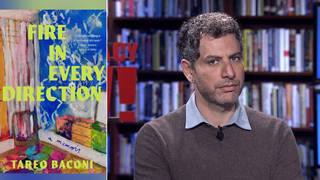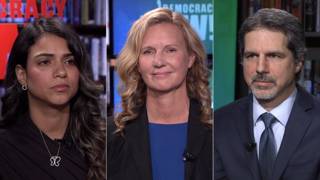
Topics
Guests
- Jessica CurtisHospital Accountability Project director at Community Catalyst based in Boston, Massachusetts.
- Elisabeth Benjaminvice president of health initiatives at the Community Service Society of New York. Their Help Line is 1-888-614-5400.
- Hope Rubeldiagnosed with benign tumor on her adrenal gland. The resulting hospital treatments left her with thousands of dollars of debt. When she was unable to pay, the hospital sued her for the money.
Links
- "Study Finds New York Hospitals Flout Charity Rules." By Nina Bernstein. (New York Times, Feb. 12, 2012)
- [PDF] Report: "Incentivizing Patience Financial Assistance: How to Fix New York’s Hospital Indigent Care Program"
- Community Service Society of New York (Help Line: 1-888-614-5400)
- Community Catalyst
As the ranks of the uninsured continue to rise, a major new study has found that most New York medical centers are violating rules intended to help patients who are uninsured and cannot afford healthcare. Two-thirds of hospitals studied either violated the law, failed to comply with state guidelines or created additional barriers to financial assistance, despite receiving a combined total of more than $463 million from the state’s Indigent Care Pool. We’re joined by three guests: Elisabeth Benjamin of the Community Service Society of New York, which conducted the two-year study; Jessica Curtis, the Hospital Accountability Project director at Community Catalyst, who says the problem is not unique to New York; and Hope Rubel, an uninsured patient who was sued some $88,000 in hospital bills by a hospital that took in more than $50 million in aid that same year. “[It] infuriated me [that] all this money is sitting in these hospitals’ bank accounts,” Rubel says. [includes rush transcript]
Transcript
NERMEEN SHAIKH: We turn now to health news. A new Gallup poll says fewer Americans now have employer-based health insurance, and the ranks of the uninsured has also risen for the fourth year in a row. In 2011, over 44 percent of Americans got their health insurance from an employer, compared to almost 46 percent in 2010. Even those who kept their jobs lost health insurance benefits because of rising costs, according to Gallup. And the percentage of Americans who are uninsured has risen to over 17 percent this year, the highest since 2008. According to Gallup, the poor economy and rising healthcare costs are weakening the job-based health insurance system that is the most common source of healthcare coverage for Americans.
Meanwhile, a major new study has found that most New York medical centers are violating rules intended to help patients who cannot afford healthcare. The state’s Indigent Care Pool, which is funded partly by a surcharge on hospital bills, distributes more than a billion dollars each year to help patients without insurance pay for medical care. But a study by the Community Service Society found two-thirds of hospitals whose aid applications were studied either violate the law, fail to comply with state guidance, or create additional barriers to assistance—despite receiving a combined total of more than $463 million for the program in 2010. Some hospitals did not even provide financial aid applications.
AMY GOODMAN: The New York Times detailed the story of one uninsured patient named Hope Rubel, who was sued by the hospital after she amassed $88,000 in hospital bills. That hospital had received more than $50 million that year to help care for uninsured patients.
We’re joined now by three guests. Here in New York, Elisabeth Benjamin is with us, vice president of health initiatives at the Community Service Society of New York, which is—she just released this two-year study on Monday. We’re also joined by Hope Rubel, the patient mentioned in the New York Times story. And from Boston, we’re joined by Jessica Curtis. She’s the Hospital Accountability Project director at Community Catalyst.
We welcome you all to Democracy Now! Hope, tell us your story. What happened? And when was it?
HOPE RUBEL: After college, I worked my entire life. I’m the typical middle-class American, in my opinion—grew up in a middle-class household, went to school, went to college, graduated, went to work, moved from job to job, better jobs, more money—the typical story. Then, in 2006, I lost a full-time job, which had health benefits, as every other job I had had up until then. And COBRA was offered at $1,500 a month, which I could not afford because I had no income. So, I took my chances. And I had always been healthy, never had any issues, major issues. I took my chances, and life rolled along for like a few years. I had freelance jobs that did not include benefits, but I had income.
And then, one day I had a headache, and it wouldn’t go away. And the next morning, my arm was numb. And I knew, intellectually, that I had had a stroke. I live not far from a major New York hospital with an exceptional reputation.
AMY GOODMAN: Which hospital?
HOPE RUBEL: New York-Presbyterian. And I went by ambulance to the emergency room, because my balance was off, as well. I knew that something significant had happened in me. Sure enough, after scans were done, it was shown I did have a stroke. I was admitted, because my blood pressure was at the emergent level.
Once admitted—well, when I was admitted, I was given a private room, because there were no double occupancy beds available. So, they chose to put me in a private room. And I was given every test under the sun for the next six days. I did receive good care. They were very thorough. But it took them six full days to figure out what had caused the stroke. At this point, all the symptoms I had had disappeared, and I was really 100 percent fine again, at that point. But they ultimately discovered a benign tumor on my adrenal gland, which was causing my—which was causing adrenaline to sporadically spurt into my system, and my blood pressure went sky high as a result, as well as my blood sugar. They determined that, because my pressure was so high, it was a bleed in my brain that had caused the stroke. This was discovered on the sixth day that I was there. And I needed to be seen by the surgeon’s team, who were going to ultimately operate and remove this tumor. I waited two days to be seen by the residents. So I’m there two extra days and was finally discharged at 10:00 on a Friday night.
I was discharged with prescriptions for pressure medication and diabetes medication, because until this tumor was removed, I was temporarily diabetic. I asked—and all the while, they knew that I wasn’t insured. And I asked the social worker if they could give me a couple of days’ worth of pills. So, I think three pills for a couple of days. And I was told, “Oh, well, we used to be able to do that, but, you know, cutbacks, so, no, we can’t.” So, I was not able to take the medication I was supposed to before bed that night, when I—because I was released that night and went home. I couldn’t take the medication I was supposed to take when I first woke up, because I had to get out of the house and go to a pharmacy to get this medication. So, that was the one thing that—well, not the one thing, but that infuriated me to the point where my head is exploding over it now, now that I know of all this money that is sitting in these hospitals’ bank accounts.
AMY GOODMAN: What were you charged? What were charged for the care? How much?
HOPE RUBEL: My total bill was $88,000.
AMY GOODMAN: Did you ask if there was any way—
HOPE RUBEL: I asked. I told them I wasn’t insured. They offered to have a social worker talk to me. At this point, I had limited vision out of my left eye, because it was like the second day I was there. I did not have pen. I did not have paper. I did not have reading glasses. I had nothing. And the social worker just tossed some papers at me with no explanation, no help whatsoever. And that was the help that was offered to me while I was there. Ultimately, I went back to the hospital two weeks later to have surgery. I had to pay $17,000 up front before being admitted for the surgery.
AMY GOODMAN: Did you understand you could get some kind of financial aid?
HOPE RUBEL: No, absolutely not.
AMY GOODMAN: Elisabeth Benjamin, this brings you into this discussion. How typical is Hope? This massive study you’ve done, not just of New York City hospitals, but the entire state, 200 hospitals in New York state.
ELISABETH BENJAMIN: Well, the reason why we brought the study was—or, we conducted the study is, the Great Recession had hit us in 2009, and we were—or, we run a statewide consumer assistance line, and our hotline was getting flooded by calls of people just like Hope. We, you know, have, I think, almost a thousand people that have contacted our network of community-based organizations in our live, toll-free hotline that helps patients in New York state. So, we conducted the study as a result of the fact that it was very common.
We were hearing story after story of clients who were getting the runaround, who were having to be—you know, to provide onerous, you know, documents, things that—the backside, a blank backside of someone’s bank statement, for example. One hospital, a very famous cancer center in New York City, wouldn’t provide financial assistance to someone who submitted 16 pages of bank records, because she hadn’t faxed in the blank sides, backsides, and denied her financial aid application. It’s just—it’s out of control—the paperwork, the burdens, whatnot.
So what we did is we said, OK, the state Department of Health, who’s passing out this money—the state Department of Health puts out $1.2 billion of federal and state funding. They’ve never audited the system. In 2006, we passed a hospital financial assistance law, which said that the hospitals must provide financial assistance on a sliding fee scale to patients. It has very strict rules. So we surveyed 201 hospitals, all 201 hospitals in New York state that gets some of the $1.2 billion, and said, “Please send us your financial aid applications. We’ll put them up on our website,” since the state Department of Health won’t put up—them up on their website, where they have an individualized profile of every hospital in New York state, down to their cardiac arrest records. You know, I mean, they have—
AMY GOODMAN: But they don’t put the financial aid form up.
ELISABETH BENJAMIN: But they won’t put the financial aid policies up for the hospitals. They put up, you know, how many beds the hospitals have, where they’re located, all their outcome statistics, you know, their hospital-acquired infection rates. I mean, you name it, it’s up there. But the financial aid policies are not.
AMY GOODMAN: And some people can be brought into a hospital unconscious. They have no control over where they’re sent.
ELISABETH BENJAMIN: Correct. And so, what we did is we put up on our website—we have a map of the state of New York. You can go by county and download all—we, you know, collected all the policies, put them up. But then we said, “This is ridiculous. Is anybody at the state Department of Health even minding the store here? They’re passing out $1.2 billion. You know, are these policies being audited?”
And sure enough, we found that even though the state Department of Health has, you know, $10,000-per-incident finding authority, not one find has ever been levered, even though some of the data that’s been submitted by the hospitals is patently, you know, incorrect on its face. I mean, it’s goofy. It’s garbage. You know, some of the reporting is just garbage from the hospitals. Some of the reporting is terrifying. One hospital has over a thousand liens on people’s homes, New Yorkers’ homes, in one year alone. Another—you know, other hospitals are demanding credit card numbers. It’s—
AMY GOODMAN: Wait, explain. And this is something that was in the New York Times, the issue of liens. That was downstate.
ELISABETH BENJAMIN: Yeah, somewhere downstate.
AMY GOODMAN: More than a thousand liens. Explain what that means. So you have a very sick patient. They come out of the hospital. The hospital puts a lien on their house?
ELISABETH BENJAMIN: Yes, what they do is—the patient doesn’t pay a bill. It’s unclear if patient has been offered financial assistance or not. By law, the hospitals are required to offer financial assistance to all their patients, on certainly all their uninsured patients, but anybody who looks like they have a problem paying a bill. It’s clear that some of the policies are just no good or very difficult to get through or don’t, in some way, follow the law or the state Department of Health’s guidance. So, the hospital then sues the patient. The hospital then sues the patient, and they—once you get a judgment against the patient—so I don’t know if Hope has a home or not in her own name, but if Columbia Presbyterian has a judgment against Hope, they, in effect, automatically have a lien on your home, because when you get a judgment, the banks sweep the court records, and once they have a judgment on you, they in effect have a lien on any of your property.
NERMEEN SHAIKH: But can you explain to us, why is that—I don’t understand. Why is it happening? I mean, are there incentives for hospitals to underwrite bad debt rather than to provide financial aid to patients who can’t pay?
ELISABETH BENJAMIN: So, that’s brilliant. You just went to the crux of the problem. The problem is, is you would think that the law would be set up that the hospitals get paid for the actual financial assistance or charity care provided to uninsured people or underinsured people. But that’s not the way the system’s set up. The way the system is set up, it has an arcane system of 10 different pools of funding that has—each has its own matrix to go—to sort of draw down money from the pool. None of it’s related to actual patients who have been certified for financial assistance. Instead, the hospitals are allowed to use—as part of the matrix, they could say, “Well, here’s all our bad debt costs.” The reason why it—and so all those bad debt costs enhance how much money the hospital gets for their so-called uncompensated care. The problem is, is once somebody like Hope gets into the bad debt bucket, instead of the charity care or financial aid bucket, is that they can then sue you. So it matters for patients very much that over 70 percent of New York’s hospitals are pulling down over 50 percent of bad debt costs towards this $1.2 billion. And that’s why the system is fatally flawed.
NERMEEN SHAIKH: I want to bring in Jennifer—sorry, Jessica Curtis into the conversation. Jessica, can you say a little about how the situation in New York compares to elsewhere in the country? Is it typical?
JESSICA CURTIS: Unfortunately, it is actually typical. So we’ve done a great deal of research and work with a lot of organizations, like Community Service Society, around the country. And what we’ve found is that situations such as the one that Hope went through, such as Elisabeth has described, are fairly typical. Now, New York is interesting, because it actually has fairly robust financial assistance laws when compared to the rest of the country. In most places, states don’t have laws requiring hospitals to notify patients about financial assistance. But what we’re finding is that even in states like New York, which have fairly robust laws, there’s a real gap between the law that’s on the books and the way that it’s actually implemented. And what I mean by that is, how much are we actually aware of in terms of how hospitals are providing financial assistance? And who is minding the store? Who is conducting oversight? What’s the penalty for a hospital that does not comply? And that’s very uneven across the country in terms of how states regulate it, how they oversee it, and so forth.
ELISABETH BENJAMIN: One thing that I would like to point out is, Jessica’s home state, Massachusetts, does have an indigent care pool that does it the right way. It’s a claims-based system, where—and maybe Jessica could talk about that, where individuals are certified eligible for financial aid, you know, like insurance, and they can go to a hospital and have, you know, on a claims basis, the money spent on their care, as opposed to—you know, we don’t know what they’re really spending all the money on here in New York.
AMY GOODMAN: Jessica?
JESSICA CURTIS: Right. So, Massachusetts has changed the incentive somewhat. Our Health Safety Net works in a way that hospitals, in order to draw down funds from the safety net, from the pooling mechanism, actually need to help patients apply for Health Safety Net services, or in some cases, what we are seeing around the country is patients who are actually eligible for Medicaid or some form of premium assistance. In Massachusetts, hospitals also need to screen patients for those programs before they can draw down from that fund. And so, it really changes the incentives from what you see in New York, where patients—or, hospitals receive payment, regardless of what happens to a patient. Here in Massachusetts, the idea has been to really sort of even out the balance a little bit by requiring hospitals to perform due diligence and make sure that patients get the help that they’re actually eligible for.
NERMEEN SHAIKH: Myrna Manners, a spokeswoman for New York-Presbyterian Hospital, told the New York Times that the hospital proactively helps patients at every step of the financial aid process. She added, quote, “Where there has been a determination that there is an ability to pay, we still go to all lengths to ensure that we resolve the matter before it becomes a legal action.” Hope Rubel, was this your experience?
HOPE RUBEL: No, not in the least. I had one brief conversation with a social worker while I was in the hospital that was fruitless for me, and then I was on my own. And then the bills started coming from the hospital, and then the phone calls, and then a collection agency, and then the lawyer. I spoke with the lawyers, and I explained to them my situation and that I did not have the money to pay this bill. And they said that we could work out a monthly payment of about $2,000 a month—would be, you know good—
AMY GOODMAN: To the hospital.
HOPE RUBEL: It would be good for them. Yeah, $2,000 a month, because it was—
AMY GOODMAN: For how many years?
HOPE RUBEL: —an $88,000—well, 'til the $88,000 was paid off. I said, “Well, I am in no position to pay that kind of money. I cannot do it. I don't know what to tell you. I can’t do it.” Then the paperwork came: they were suing me. And I was like, “All right, this is a whole ’nother story now.” I have no money to hire a lawyer. I’m not working. I am living off savings to just pay my expenses. I had already spent $17,000 for the surgery.
AMY GOODMAN: So, you go to court.
HOPE RUBEL: So—
AMY GOODMAN: You represented yourself?
HOPE RUBEL: I represented myself.
AMY GOODMAN: And what deal did you work out?
HOPE RUBEL: After a year of eight meetings with the hospital’s lawyer and the court clerks, back and forth, I felt backed into a corner after a year, because I know that when applying for a job, in New York, at least, background checks are done on people. You know, things are different after, you know, 9/11. There are extensive background checks that are done on people when applying for just a job. And I did not—I couldn’t have this hanging over my head, because I was at—
AMY GOODMAN: So what did you work out?
HOPE RUBEL: I was at risk for not being able to get employment because of this. I offered $100 a month, thinking that there was—
AMY GOODMAN: For the rest of your life?
HOPE RUBEL: Well, I offered a hundred dollars a month, thinking that there was no way that they would accept this. Apparently, the judge encouraged the hospital to accept my offer. I started paying them $100 a month this past October. It will take 73 years for me to pay them off.
AMY GOODMAN: Elisabeth Benjamin, is this a done deal? I mean, does Hope Rubel have any other recourse at this point?
ELISABETH BENJAMIN: Well, if Hope were to come to the Community Service Society’s Community Health Advocates Program, we have a team of amazing lawyers. And what they would do, if—you know, we’d be in consultation with Hope, and, you know, if Hope wants us to do this—and we provide our services free of charge—is that we will go with Hope, review her papers, and see if we can vacate that settlement and see if we can work out—I want to review those papers to see if they’re charging her for the rack rate, the full charges, or a discounted charge, because if she’s eligible for financial assistance and we can prove that, then I think she doesn’t really probably have an $88,000 debt.
AMY GOODMAN: And how much is New York-Presbyterian getting, how many millions of dollars from New York state, to cover people, well, that are supposed to be like Hope?
ELISABETH BENJAMIN: Right. Over $50 million.
AMY GOODMAN: Well, I think we’re going to leave it there, and I thank you all very much for being with us. If people want to get in touch with the Community Service Society, Elisabeth Benjamin, where do they go?
ELISABETH BENJAMIN: They can call our 800 number: 888-614-5400. Or we can—you can reach us through the internet at www.communityhealthadvocates.org. And just google “Community Health Advocates,” and you’ll find us.
AMY GOODMAN: Elisabeth Benjamin is the vice president of Community Service Society in New York, who has put out this remarkable two-year report, and we’ll link to it at democracynow.org. Hope Rubel, thanks so much for being with us. Did I pronounce your name right, by the way?
HOPE RUBEL: Yes.
AMY GOODMAN: Very good. We want to get something right here. And thank you very much, Jessica, for joining us. Jessica Curtis’s Community Catalyst organization in Boston.
This is Democracy Now! When we come back, it’s the first-year anniversary of the Wisconsin uprising. John Nichols will be with us. Thank you.











Media Options